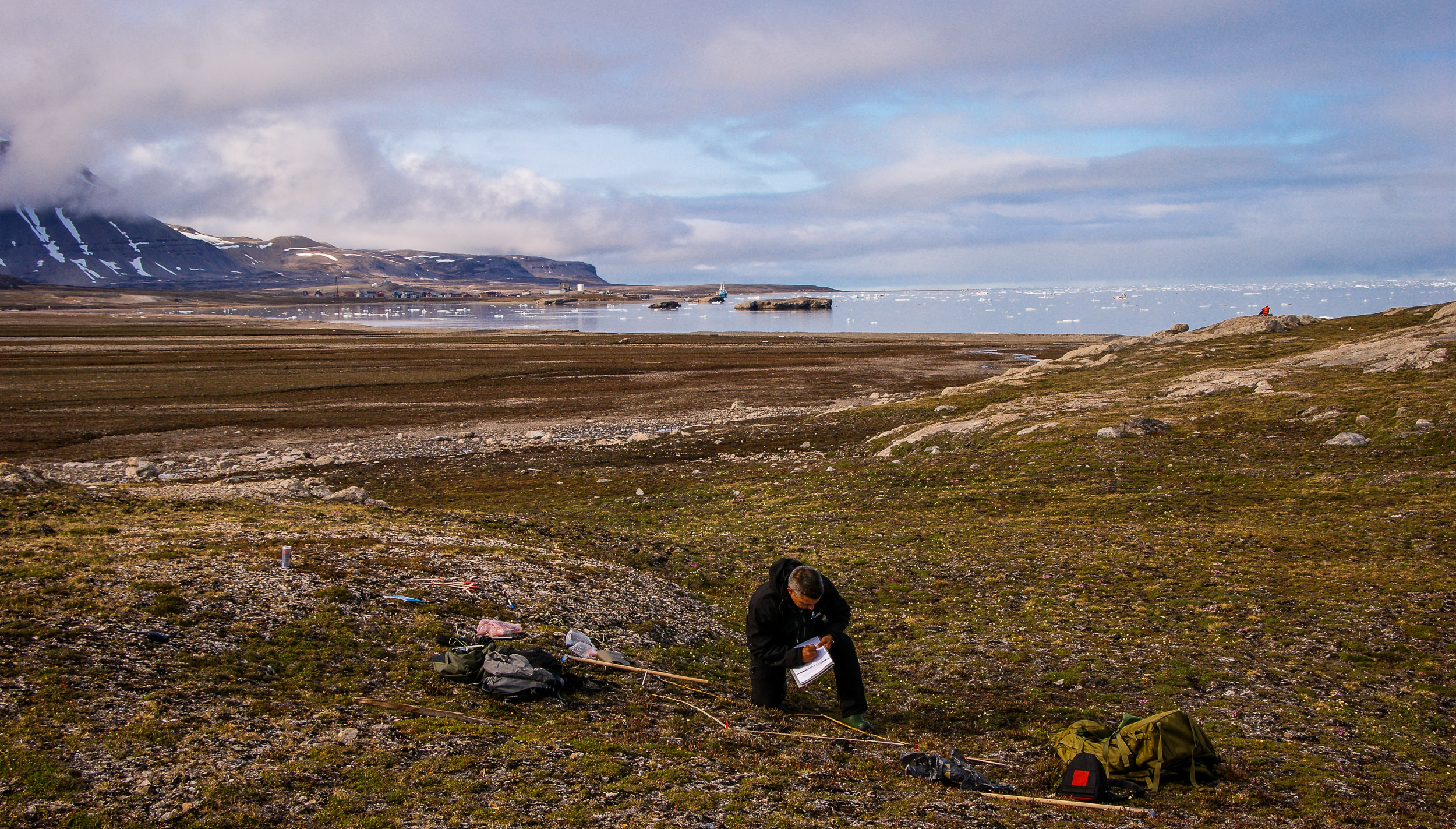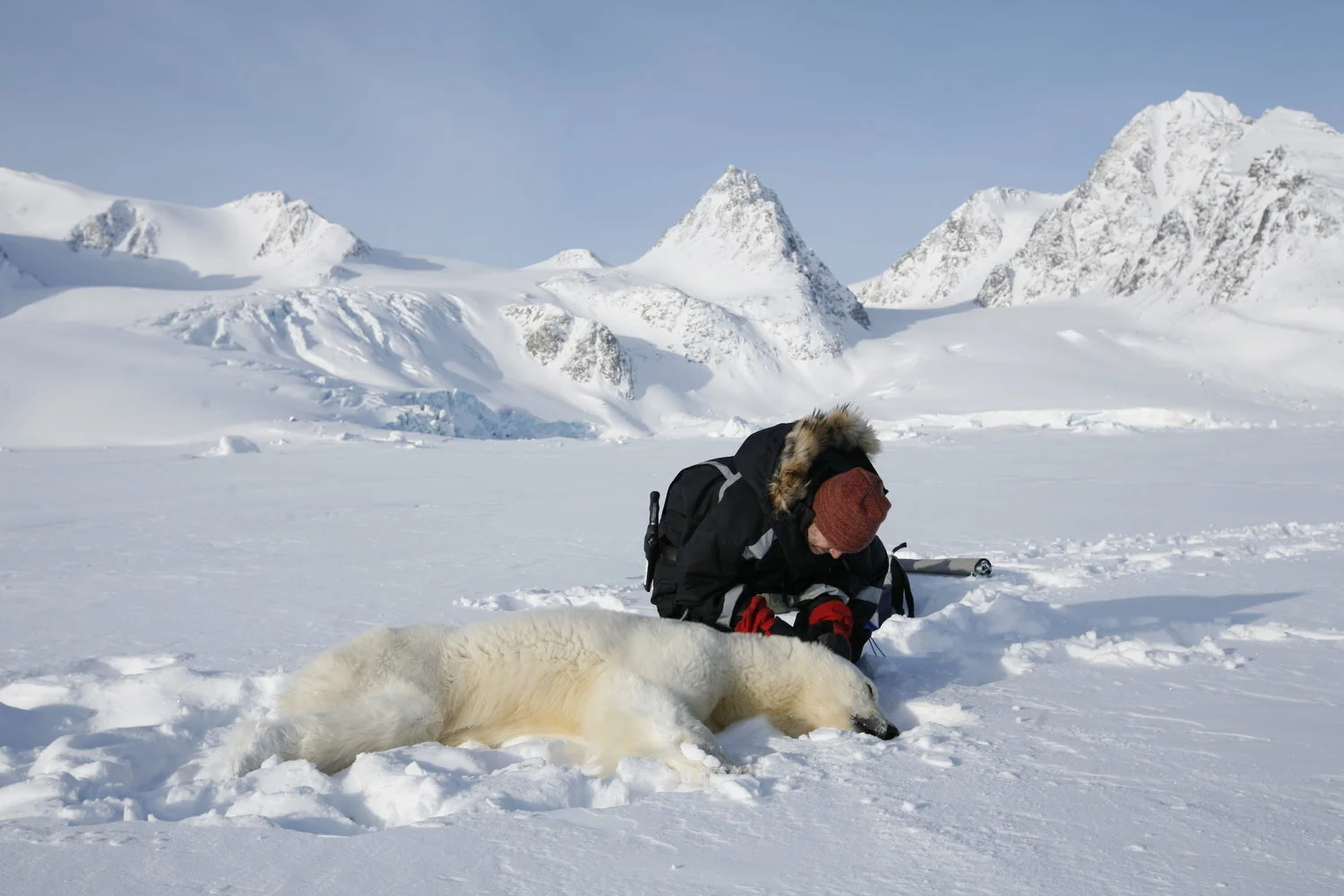Warmer Winters Are Making The Arctic Greener - With One Exception
Science
Writer: Helge M. Markusson // Fram Center
Photographs: Trond Johnsen, Jarle W. Bjerke
January 2019
Effects of Climate change are making the Arctic greener. Satellite monitoring shows a denser and higher vegetation cover in large parts of the Arctic, especially in the warmest areas bordering the boreal forest zones. Admittedly, since 2010, there have been a few years in between, when vegetation has not gotten greener, according to the annual Arctic Report Card, but the main characteristics are not to be mistaken: the Arctic has become warmer and greener. Only, just not in one particular part - Svalbard.
Svalbard is the Norwegian archipelago between mainland Norway and the North Pole, stretching between 74° to 81° north. Glaciers cover some 60% of Svalbard. Roughly 2000 people live on Spitzbergen, Svalbard´s largest island. Most in Longyearbyen the administrative town, but some in Barentsburg, a Russian mining town and in Ny-Ålesund, the northernmost settlement in the world with a permanent civilian population of an international science research community. Ny-Ålesund (seen in the background of the picture below) holds a unique place and position in Arctic research, as described in JONAA’s article: Science at the end of the Earth. Map/Google.
Why does vegetation not follow the rise in summer temperatures?
“The far north is becoming greener. Yet, in part of the Arctic, on Svalbard, we are uncertain about what is happening. Climate change has led to warmer summers, but at the same time the winters are also having a negative influence on vegetation. We have not had much information before now on the development of vegetation on Svalbard says Jarle W. Bjerke, a senior researcher at the Norwegian Institute for Nature Research (NINA) at the Fram Centre, who has been taking a close look at this phenomenon.
"On the map that covers the entire Arctic, Svalbard is most often marked in white, which means the data is missing. This is because the longest time series on vegetation greenness is based on satellite data with low spatial resolution. With such low resolution, most pixels covering Svalbard are influenced by glaciers and mountains with almost no vegetation. We have therefore been uncertain as to how vegetation on Svalbard is developing," says Bjerke.
It was not until the publication in 2016 of a time series analysis of the vegetation in the central parts of Isfjorden, including the Longyearbyen area and Adventdalen, that researchers got some very welcome information about vegetation development on Spitsbergen, Svalbards largest island. This study is based on satellite data for the period 1986 to 2015 with 1-km spatial resolution. The time series show that vegetation in this area of Spitsbergen became slightly greener during this period, but there were large year-to-year variations. In the same period, the temperature in the growing season (from 16 May to 31 July) increased on average by 0.065 °C per year.
The correlation between greenness and temperature in the growing season was good for the entire period as a whole, but by breaking the figures down into 15-year periods, the studies indicated that the correlation was far weaker in the latter than in the first part of the study period. What could be the reason for the reduced correlation between these two variables? Why did vegetation not continue to follow the rise in summer temperatures?
A February, 14.5 degrees warmer than normal
A strong indication of the causes came in a another study of changes in winter climate on Svalbard, published in 2016. "From the end of the 1960s up to 2015, winter temperatures (October to April) increased by about 5 degrees. The temperature for July for the same period increased by "only" approximately 2 degrees. The change in winter climate on Svalbard is visible in more and stronger waves of mild weather,”explains Bjerke. “For example, in February 2014 many long periods of mild weather were reflected in record-high monthly mean temperatures. At Svalbard Airport near Longyearbyen, February was 14.5 degrees warmer than normal. A similar deviation from the monthly mean temperature would give an average temperature in February of about 10 degrees in Oslo and 15 degrees in Stavanger! At Svalbard Airport, all February-months since 2000, except one, have been warmer than normal."
Mild winters reduce snow cover for plants
While warmer weather during the summer stimulates growth rates high at northern latitudes where drought is hardly a problem, warmer winter weather leads to more stress.
"Vegetation in areas normally covered by snow during the winter (be it in the forested Nordmarka area of Oslo or in the Adventdalen valley on Svalbard) is used to going dormant in the winter with snow as a protective blanket. Periods of mild weather reduce snow cover, and hence the degree of insulation. The entire snow cover can often thaw away, or a thick layer of ice forms on the ground during short periods of cold. Such interference can damage the vegetation. We knew about this for other vegetation species like heather in the northern boreal birch forest and in the low alpine heath and the grasslands used to produce coarse fodder/roughage," Bjerke says.
Significant damage to vegetation
Bjerke and other researchers discovered significant damage to vegetation on Svalbard during the summers of 2014 and 2015. The damage was especially great for evergreen plants and other plants that survive the winter with buds and shoots above ground.
"White arctic bell-heather, a beautiful dwarf shrub with white bell-shaped flowers, was one of the species we monitored. The severity of damage to this increased from 2014 to 2015. While the damaged branches of this plant were grey in 2014, and more or less leafless, the damage from 2015 was brown and the leaves were still hanging on. The mountain avens, a creeping plant with large white rose flowers, was also much damaged in both years. In our report on this damage, we were able to determine that the winters of 2011/12 and 2014/15 had large quantities of precipitation as rain. Much of the vegetation was exposed to weather and wind during these winters, while the rest of the tundra was covered in ice.
We concluded that the older damage observed in 2014 was due to the first of these two winters, while the fresh damage observed in the summer of 2015 was caused by the winter of 2014/15. We found strong indications that both the ice sheet and full exposure led to damage to the vegetation," say Bjerke.
,
White arctic bell-heather with mostly dead shoots (grey and brown), some healthy shoots (green), and a shoots infested by a fungus (red). JONAA©Jarle W. Bjerke
Detail of dead shoots of white arctic bell-heather. Polar willow is seen with green oval leaves. JONAA©Jarle W. Bjerke
Contrary to what one might think, the flora on Spitsbergen, the largest and only permanently populated island of the Svalbard archipelago, is not benefiting from warmer winters. This photograph shows a dead purple saxifrage. JONAA©Jarle W. Bjerke
Scientists now know that a number of other winters since 2000 have had similar problems to snow and ice conditions. This led to starvation among reindeer and rock ptarmigan on Svalbard. Increased winter stress is, therefore, the most likely cause of declining vegetation greenness as measured from the satellite, which is no longer increasing with rising summer temperature.
"We also monitored vegetation at Spitsbergen in 2016 and 2017. These results are not yet completed and reported, but we can say so that we have not found any clear sign of recovery of the damaged areas," Bjerke said.
Extreme precipitation and thawing permafrost
In addition to disturbances to the snow cover in winter, the vegetation on Svalbard is also exposed to other types of pressure. Periods of extreme precipitation in the winter season led to a number of slush torrents in steep terrain, which washed away the vegetation layer. Where the vegetation has not been removed silt and clay have formed on top of the vegetation, which can be harmful to plants and lichen. Svalbard's coastline is increasingly prone to erosion, primarily due to thawing permafrost. Thawing permafrost will also have an impact on inland areas, in the valleys, where several observers have noticed the tundra breaking up from new streams of thaw water, while the existing gullies are becoming increasingly larger due to edge erosion. Thawing permafrost is probably due to the fact that much of frost does not reach as deep as it did in past winters, more so than that the summer climate has been warmer.
"As long as the winter climate keeps changing faster than the summer climate, there is little evidence that the vegetation on Svalbard will be greener," quotes Bjerke.
"Nevertheless, some plants that spend the winter underground, and which thus are less vulnerable to changes to the winter climate, may increase in cover and quantity. This applies in particular to the many tufted kinds of grass living in humid parts of the tundra. Grasses and sedges may increase in quantity at the expense of the white arctic bell-heather, mountain avens and other plants that spend the winter with shoots and buds above the ground," Bjerke said in conclusion.
The vegetation on Svalbard is facing an uncertain future. ▢
Warmer winters on Svalbard are not tantamount to a greener landscape. This was the conclusion from new research by Jarle W. Bjerke and others at the Norwegian Institute for Nature Research (NINA) at the Fram Centre.
More Science:
References to the study:
Bjerke J.W., Karlsen S.R., Høgda K.A., Malnes E., Jepsen J.U., Lovibond S., Vikhamar-Schuler D. & Tømmervik H. 2014: Record-low primary productivity and high plant damage in the Nordic Arctic Region in 2012 caused by multiple weather events and pest outbreaks. Environmental Research Letters 9: 084006.
Bjerke J. W., Tømmervik H., Zielke M. & Jørgensen M. 2015: Impacts of snow season on ground-ice accumulation, soil frost and primary productivity in a grassland of sub-Arctic Norway. Environmental Research Letters 10: 095007.
Bjerke J.W., Treharne R., Vikhamar-Schuler D., Karlsen S.R., Ravolainen V., Bokhorst S., Phoenix G.K., Bochenek Z. & Tømmervik H. 2017. Understanding the drivers of extensive plant damage in boreal and Arctic ecosystems: Insights from field surveys in the aftermath of damage. The science of the Total Environment 599-600: 1965-1976.
Bokhorst S., Bjerke J.W., Tømmervik H., Callaghan T.V. & Phoenix G.K. 2009: Winter warming events damage sub-Arctic vegetation: consistent evidence from an experimental manipulation and a natural event. Journal of Ecology 97: 1408-1415.
Epstein H.E., Bhatt U.S., Raynolds M.K., Walker D.A., Forbes B.C., Horstkotte T., Macias-Fauria M., Martin A., Phoenix G.K., Bjerke J.W., Tømmervik H., Fauchald P., Vickers H., Myneni R. & Dickerson C. 2017. Tundra greenness. In: Richter-Menge J., Overland J.E., Mathis J.T. & Osborne E. (Red.): Arctic Report Card 2017. National Oceanic and Atmospheric Administration, Silver Spring, MD, USA. Available at: http://www.arctic.noaa.gov/Report-Card
Vikhamar-Schuler D., Isaksen K., Haugen J.E., Tømmervik H., Luks B., Schuler T.V. & Bjerke J.W. 2016: Changes in winter warming events in the Nordic Arctic Region. Journal of Climate 29 : 6223-6244.
The results discussed here are from projects funded by EEA's Poland-Norway-program, the Research Council of Norway's, The Fram Centre and the Svalbard Environmental Protection Fund.
Helge M. Markusson works as Outreach Coordinator at The Fram Centre (FRAM High North Research Centre for Climate and the Environment). Author and columnist. Former journalist of newspapers, radio and TV. Has also been involved in a series of smaller and bigger culture projects. Raised in Northern Norway, living in Tromsø, Norway. Helge is a member of the JONAA founding team.














